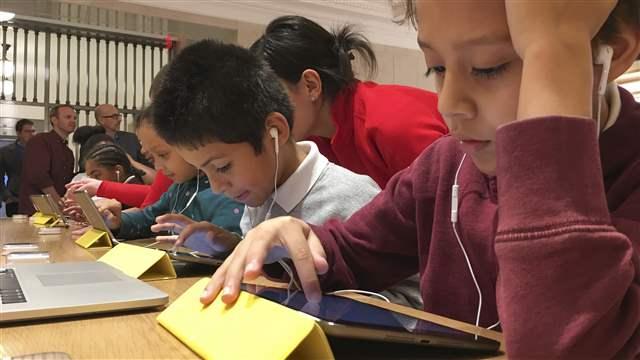Twenty years ago this week, one of my very first writings on education policy appeared in print.[i] It was an opinion piece I wrote while teaching middle school in East Harlem, in which I described my school’s struggle to effectively use classroom computers. Two decades later, as a professor of economics and education policy, I am engaged in several research projects studying the use and impact of digital learning.[ii]
Much has changed since I taught middle school. I am struck by the extent to which recent technological innovations have created many new opportunities to better serve traditionally disadvantaged students.
First, increasing speed and availability of internet access can reduce many of the geographic constraints that disadvantage poor students. Schools serving higher-resourced families are often able to recruit better teachers and administrators—perhaps the most important school resources—even without additional funding.
Unlike teachers, however, technologies have no preferences for the schools in which they work. The resources available on the internet, for example, are equally available to all schools with the same internet access and internet access costs the same for all schools in the same area, regardless of the student population served. Students can now access online videos that provide instruction on a wide variety of topics at various skill levels, and participate in real-time video conferences with teachers or tutors located a state (or even a continent) away.[iii]
Second, the evolution of touch-screen technology has enabled very young children to engage in technology-aided instruction. Prior to tablets, it was difficult for pre-school, kindergarten and even early primary grade students to work with educational software because it required use of a mouse or keyboard. Now there are a hundreds of applications that can effectively expose children to early literacy and numeracy skills.
Third, advances in artificial intelligence technology now allow teachers to differentiate instruction, providing extra support and developmentally-appropriate material to students whose knowledge and skill is far below or above grade level norms. The latest “intelligent” tutoring systems are able to not only assess a student’s current weaknesses, but also diagnose why students are making specific errors.[iv] These technologies could enable teachers to better reach students who are further from the average within their classroom, potentially benefiting students with weaker academic preparation.
And these technologies scale easily so that innovations (or even good curriculum) can reach more students. Much like a well-written textbook, a well-designed educational software application or online lesson can reach students not just in a single classroom or school, but across the state or country.
While technologies such as virtual instruction and intelligent tutoring offer great promise, unless the challenges that are associated with implementing them are fully understood and addressed their failure is almost surely guaranteed. To date, there is little evidence that digital learning can be implemented at scale in a way that improves outcomes for disadvantaged students.
Hundreds of thousands of students attend full-time online schools,[v] but a study released last year found that students of online charter schools had significantly weaker academic performance in math and reading, compared with demographically similar students in conventional public schools.[vi] Computer-aided instruction has been studied extensively over the past twenty-five years and the findings have not been encouraging. Consistently, programs that are implemented widely and evaluated with rigorous methods have yielded little to no benefit for students on average.[vii]
What are the key challenges?
Let’s start with student motivation. If technologies can draw in otherwise disenfranchised students through the personalization of material to a student’s interest or through gaming technology, they could benefit disengaged, poorly performing students. However, these technologies often reduce oversight of students, which could be particularly detrimental for children who are less motivated or who receive less structured educational supports at home. It is also possible that these technologies will be less able to engage reluctant learners in the way a dynamic and charismatic teacher can.
Moreover, approaches that forgo direct interpersonal interaction completely are unlikely to be able to teach certain skills. Learning is an inherently social activity. While an intelligent tutor might be able to help a student master specific math concepts, it may not be able to teach students to critically analyze a work of literature or debate the ethics of new legislation.
The experience of Rocketship, a well-known charter school network, illustrates this concern. Developed in the Bay Area of California in 2006, Rocketship’s instructional model revolves around a blended learning approach in which students spend a considerable amount of each day engaged with computer-aided learning technologies. The network received early praise for its innovative approach to learning and, most importantly, for the high achievement scores posted by its mostly poor, nonwhite student population. In 2012, however, researchers and educators raised concerns about graduates from Rocketship elementary schools, noting that they had good basic skills but were struggling with the critical analysis required in middle school.[viii]
More broadly, it is important to realize that technologies can be either substitutes for or complements to resources already in the school. To the extent that they are substitutes, they are inherently equalizing forces. For example, well-designed and structured online content might provide critical support to a novice teacher who is too overwhelmed to produce the same coherent and engaging materials that some more experienced teachers can create.
However, in many cases it may be more appropriate to think of technologies as complements—e.g., when they require skilled teachers or students with strong prior skills to be implemented well. In these cases, technologies must be accompanied with additional resources in order for them to benefit traditionally underserved populations.
Perhaps most importantly, systems that blend computer-aided and face-to-face instruction are notoriously difficult to implement well. In recent studies of the popular Cognitive Tutor math programs, teachers reported trouble implementing the program’s instructional practices that revolve around collaborative work, making strong connections between computer-based activities and classroom instruction, and maintaining the expected learning pace with many students who lacked prior math and reading skills.[ix]
Finally, even with the best implementation, digital learning is likely to benefit students differently depending on their personal circumstances and those of their school. For instance, non-native English speakers might benefit from online instruction that allows them to pause and look up unfamiliar words. Likewise, we might expect an online course to be more advantageous for students attending a brick-and-mortar school with very low-quality teachers.
Indeed, some recent research finds exactly this type of heterogeneity. A large IES-funded evaluation of computer-aided instruction (CAI) released in 2007 found that students randomly assigned to teachers using the leading CAI products fared no better than students in control classrooms. Several years later, then graduate student Eric Taylor, decided to reanalyze the data from the study, focusing on whether the impacts of these technologies varied across classrooms. His analysis suggests that the introduction of computer-aided instruction had a positive impact on students in classrooms with less effective teachers and a negative impact on students in classrooms with more effective teachers.[x]
In recent years, the worlds of online learning and computer-aided instruction have converged to some extent, morphing into what is often referred to as blended- or personalized-learning models. There are a number of interesting projects underway across the country, including pilots supported by the Gates Foundation’s Next Generation Learning Challenge, and the emergence of charter networks with a goal to provide truly personalized learning for every student, such as Summit Public Schools in California and Washington.[xi]
In order for these new endeavors to be successful, they must overcome the challenges described above.
[i] http://www.edweek.org/tm/articles/1996/05/01/08jacob.h07.html
[ii] In a recent publication, the International Association for K-12 Online Learning defined digital learning as “any instructional practice in or out of school that uses digital technology to strengthen a student’s learning experience and improve educational outcomes.”
[iii] This technology has even expanded opportunities for the long-distance professional development of teachers, enabling novice teachers to receive mentorship from master teachers regardless of distance.
[iv] http://www.apa.org/pubs/books/4311503.aspx?tab=2
[v] http://www.inacol.org/wp-content/uploads/2015/11/Keeping-Pace-2015-Report.pdf
[vi] https://credo.stanford.edu/pdfs/Online%20Charter%20Study%20Final.pdf
[vii] http://www.sciencedirect.com/science/article/pii/S1747938X13000031
http://psycnet.apa.org/journals/edu/105/4/970/?_ga=1.79079444.1486538874.1462278305
http://www.apa.org/pubs/journals/features/edu-a0037123.pdf
http://rer.sagepub.com/content/86/1/42.abstract
[viii] http://www.edweek.org/ew/articles/2014/01/21/19el-rotation.h33.html?qs=New+Model+Underscores+Rocketship%E2%80%99s+Growing+Pains
http://educationnext.org/future-schools/
[ix] http://epa.sagepub.com/content/36/2/127.abstract
http://www.tandfonline.com/doi/full/10.1080/19345741003681189
The Brookings Institution is committed to quality, independence, and impact.
We are supported by a diverse array of funders. In line with our values and policies, each Brookings publication represents the sole views of its author(s).





